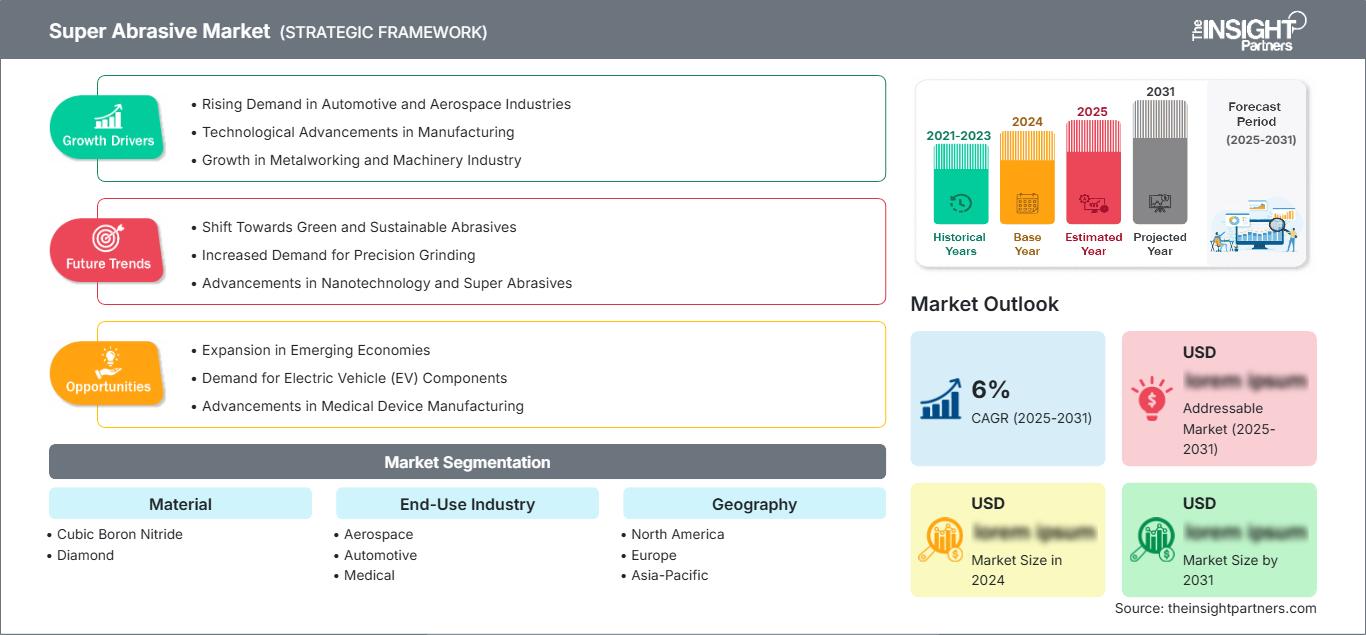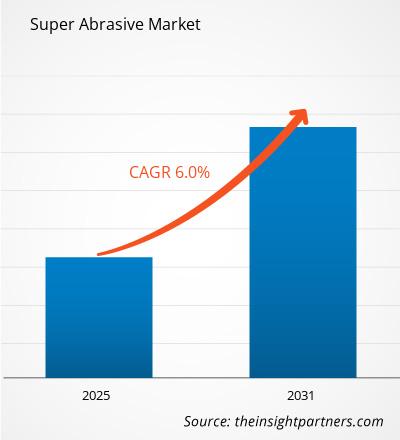Si prevede che il mercato dei super abrasivi raggiungerà i 10,35 miliardi di dollari entro il 2031. Si prevede che il mercato registrerà un CAGR del 6,2% nel periodo 2025-2031.
Il rapporto è segmentato per materiale (nitruro di boro cubico, diamante). Il rapporto presenta inoltre un'analisi basata sul settore di utilizzo finale (aerospaziale, automobilistico, medicale, elettronico, petrolifero e del gas, del legno, della lavorazione dei metalli, altri). L'analisi globale è ulteriormente suddivisa a livello regionale e per i principali paesi. In termini geografici, il mercato è suddiviso in Nord America, Europa, Asia-Pacifico, Medio Oriente e Africa, America meridionale e centrale. Il rapporto fornisce il valore in dollari per l'analisi e i segmenti sopra indicati.
Scopo del rapporto
Il rapporto "Super Abrasive Market" di The Insight Partners mira a descrivere il panorama attuale e la crescita futura, i principali fattori trainanti, le sfide e le opportunità. Ciò fornirà spunti a vari stakeholder aziendali, come:
- Fornitori/produttori di tecnologia: per comprendere le dinamiche di mercato in evoluzione e conoscere le potenziali opportunità di crescita, consentendo loro di prendere decisioni strategiche informate.
- Investitori: per condurre un'analisi completa delle tendenze in merito al tasso di crescita del mercato, alle proiezioni finanziarie del mercato e alle opportunità esistenti lungo la catena del valore.
- Organismi di regolamentazione: per regolamentare le politiche e le attività di controllo nel mercato con l'obiettivo di ridurre al minimo gli abusi, preservare la fiducia degli investitori e sostenere l'integrità e la stabilità del mercato.
Materiale di segmentazione del mercato dei super abrasivi
- Nitruro di boro cubico
- Diamante
Industria di utilizzo finale
- Aerospaziale
- Automotive
- Medico
- Elettronica
- Petrolio e gas
- Legno
- Lavorazione dei metalli
Potrai personalizzare gratuitamente qualsiasi rapporto, comprese parti di questo rapporto, o analisi a livello di paese, pacchetto dati Excel, oltre a usufruire di grandi offerte e sconti per start-up e università
Mercato dei super abrasivi: Approfondimenti strategici

-
Ottieni le principali tendenze chiave del mercato di questo rapporto.Questo campione GRATUITO includerà l'analisi dei dati, che vanno dalle tendenze di mercato alle stime e alle previsioni.
Fattori di crescita del mercato dei super abrasivi
- Crescente domanda nei settori automobilistico e aerospaziale: il mercato dei super abrasivi è trainato dalla crescente domanda di lavorazioni meccaniche ad alta precisione nei settori automobilistico e aerospaziale. I super abrasivi come il nitruro di boro cubico (CBN) e il diamante sono fondamentali per la produzione di componenti con tolleranze rigorose, garantendo prestazioni e durata migliorate in questi settori.
- Progressi tecnologici nella produzione: i continui progressi nelle tecnologie di produzione, come le macchine a controllo numerico computerizzato (CNC), stanno alimentando la domanda di super abrasivi. Questi materiali sono essenziali per ottenere finiture superficiali superiori e un'elevata precisione in settori come la lavorazione dei metalli, l'elettronica e la produzione di utensili, favorendo la crescita del mercato dei super abrasivi.
- Crescita nel settore della lavorazione dei metalli e dei macchinari: l'espansione dei settori della lavorazione dei metalli e dei macchinari contribuisce in modo significativo al mercato dei super abrasivi. Con la crescente necessità di taglio, rettifica e lucidatura di metalli e materiali duri, i super abrasivi come il diamante e il CBN sono essenziali per ottenere lavorazioni ad alte prestazioni ed efficienti, trainando la domanda del mercato.
Tendenze future del mercato dei super abrasivi
- Spostamento verso abrasivi ecologici e sostenibili: nel mercato dei super abrasivi si registra una crescente tendenza verso materiali ecocompatibili e sostenibili. I produttori si stanno concentrando sullo sviluppo di abrasivi che producono meno polvere, riducono gli sprechi e sono realizzati con materiali riciclabili, in linea con gli obiettivi di sostenibilità globale e riducendo l'impatto ambientale.
- Crescita della domanda di rettifica di precisione: poiché le industrie richiedono lavorazioni più precise e complesse, la domanda di super abrasivi è in aumento. Le applicazioni nei settori aerospaziale, automobilistico ed elettronico stanno determinando la necessità di abrasivi che offrano precisione eccezionale, finiture lisce ed elevata efficienza nelle applicazioni di rettifica, lucidatura e taglio.
- Progressi nella nanotecnologia e nei super abrasivi: l'integrazione della nanotecnologia con i super abrasivi sta emergendo come una tendenza chiave. Migliorando le prestazioni e l'efficienza dei super abrasivi, la nanotecnologia consente un taglio e una rettifica più precisi, offrendo risultati migliori nella produzione di materiali avanzati e microcomponenti, guidando l'innovazione nel mercato.
Opportunità di mercato dei super abrasivi
- Espansione nelle economie emergenti: il mercato dei super abrasivi offre opportunità di crescita nelle economie emergenti, dove l'industrializzazione e la produzione stanno progredendo rapidamente. La crescente domanda di materiali ad alte prestazioni in settori come l'automotive, l'aerospaziale e l'edilizia offre un mercato in espansione per i super abrasivi, in particolare in regioni come l'Asia-Pacifico e l'America Latina.
- Domanda di componenti per veicoli elettrici (EV): l'ascesa dei veicoli elettrici offre un'opportunità per i super abrasivi nella produzione di componenti ad alta precisione come motori, batterie e ingranaggi. I super abrasivi sono essenziali per la produzione di componenti con tolleranze rigorose e superfici lisce, soddisfacendo la crescente domanda di tecnologie avanzate per i veicoli elettrici.
- Progressi nella produzione di dispositivi medici: i super abrasivi offrono opportunità nel settore in crescita dei dispositivi medici. Con la crescente domanda di strumenti medici altamente precisi e complessi, i super abrasivi sono essenziali per la produzione di componenti con tolleranze ristrette, finiture di pregio ed elevata durata, supportando l'espansione di tecnologie sanitarie e dispositivi medici avanzati.
Le tendenze regionali e i fattori che influenzano il mercato dei super abrasivi durante il periodo di previsione sono stati ampiamente spiegati dagli analisti di The Insight Partners. Questa sezione illustra anche i segmenti e la geografia del mercato della gestione delle malattie del ritmo cardiaco in Nord America, Europa, Asia-Pacifico, Medio Oriente e Africa, America meridionale e centrale.
Ambito del rapporto sul mercato dei super abrasivi
| Attributo del rapporto | Dettagli |
|---|---|
| Dimensioni del mercato in 2024 | US$ XX Billion |
| Dimensioni del mercato per 2031 | US$ 10.35 Billion |
| CAGR globale (2025 - 2031) | 6.2% |
| Dati storici | 2021-2023 |
| Periodo di previsione | 2025-2031 |
| Segmenti coperti |
By Materiale
|
| Regioni e paesi coperti |
Nord America
|
| Leader di mercato e profili aziendali chiave |
|
Densità degli operatori del mercato dei super abrasivi: comprendere il suo impatto sulle dinamiche aziendali
Il mercato dei super abrasivi è in rapida crescita, trainato dalla crescente domanda degli utenti finali, dovuta a fattori quali l'evoluzione delle preferenze dei consumatori, i progressi tecnologici e una maggiore consapevolezza dei vantaggi del prodotto. Con l'aumento della domanda, le aziende stanno ampliando la propria offerta, innovando per soddisfare le esigenze dei consumatori e sfruttando le tendenze emergenti, alimentando ulteriormente la crescita del mercato.

- Ottieni il Mercato dei super abrasivi Panoramica dei principali attori chiave
Punti di forza
- Copertura completa: il rapporto analizza in modo esaustivo prodotti, servizi, tipologie e utenti finali del mercato dei super abrasivi, offrendo una panoramica olistica.
- Analisi degli esperti: il rapporto è redatto sulla base della conoscenza approfondita di esperti e analisti del settore.
- Informazioni aggiornate: il rapporto garantisce la pertinenza aziendale grazie alla copertura di informazioni e dati recenti.
- Opzioni di personalizzazione: questo rapporto può essere personalizzato per soddisfare le esigenze specifiche del cliente e adattarsi in modo appropriato alle strategie aziendali.
Il rapporto di ricerca sul mercato dei super abrasivi può quindi aiutare a guidare il percorso di decodificazione e comprensione dello scenario del settore e delle prospettive di crescita. Sebbene possano esserci alcune valide preoccupazioni, i vantaggi complessivi di questo rapporto tendono a superare gli svantaggi.
- Analisi storica (2 anni), anno base, previsione (7 anni) con CAGR
- Analisi PEST e SWOT
- Valore/volume delle dimensioni del mercato - Globale, Regionale, Nazionale
- Industria e panorama competitivo
- Set di dati Excel
Report recenti
Testimonianze
Motivo dell'acquisto
- Processo decisionale informato
- Comprensione delle dinamiche di mercato
- Analisi competitiva
- Analisi dei clienti
- Previsioni di mercato
- Mitigazione del rischio
- Pianificazione strategica
- Giustificazione degli investimenti
- Identificazione dei mercati emergenti
- Miglioramento delle strategie di marketing
- Aumento dell'efficienza operativa
- Allineamento alle tendenze normative






















 Ottieni un campione gratuito per - Mercato dei super abrasivi
Ottieni un campione gratuito per - Mercato dei super abrasivi